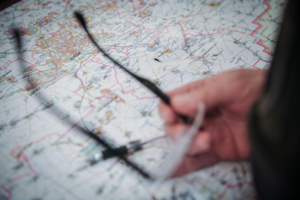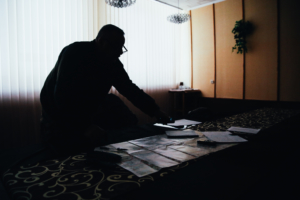Aug. 29: Key events of the day
At dawn, some 1,500 of Ukraine’s army soldiers and volunteer fighters left their positions in Ilovaisk and areas nearby and gathered between the villages of Ahronomichne and Mnohopillia, hoping to leave encirclement in accordance with preliminary agreements with the Russians. As a safety precaution, they divided into two columns, which were to march south by two different routes and meet up once they were through Russian lines.
But the preliminary talks broke down – the Russian officers demanded that the Ukrainian troops had to surrender their arms before leaving the area. Ukraine’s commander on the spot, General Ruslan Khomchak, ordered his soldiers to fight their way out of encirclement. But exhausted and disorganized, many of the Ukrainian troops weren’t aware they were expected to fight, and kept their weapons stowed in cases. Many traveled in unarmored civilian cars and minivans.
The Russians attacked the Ukrainian columns near the villages of Chumaky and Chervonosilske, firing at the civilian vehicles with grenade launchers and machine guns. Hundreds of Ukrainians were killed or were taken captive. Dozens of Russian troops were also killed in fire fights, according to Ukrainians soldiers. The Ukrainian side then retaliated with air strikes and missile attacks. At the end of the day, the military commanders from both sides started negotiations to end the carnage.

Colonel Mykhailo Kovalsky shows a map of Donetsk Oblast (Oleg Petrasiuk).
Aug. 29, early morning. A road by the village of Ahronomichne
Colonel Mykhailo Kovalsky fastened a square white piece of a bedsheet to an electric pole, marking the meeting point for the Russian armored vehicles that were expected to arrive soon.
Two Russian APCs were to lead two Ukrainian military columns to ensure their safe passage out of the encirclement in Ilovaisk, where around 1,500 soldiers had been surrounded and heavily shelled by Russian troops for nearly a week.
It was part of an agreement reached between Ukrainian and Russian commanders a few days earlier.
To ward off attack, the Ukrainians held captive two Russian soldiers: They were to travel in the columns and later be handed over to the Russians.
Kovalsky, the head of the engineering service for Operations Command South with nom-de-guerre Dynamite, was in charge of forming a column in Ahronomichne, called the Mace (“Bulava” in Ukrainian), which consisted of over 1,000 soldiers in dozens of armored vehicles and civilian minivans.
But only one Russian UAZ off-road vehicle arrived and stopped for talks by the second Ukrainian column, called the Wind, located 5 kilometers to the east in the village of Mnohopillia. This column had another dozen armored vehicles and nearly 450 soldiers.
The soldiers, tired and desperate, stood for several hours ready to leave, waiting for their fate to be decided. The sounds of grenade launchers firing nearby put many of them on edge.

Mykhailo Kovalsky stands beside a map of Donetsk Oblast at a military base in the village of Honcharivske, Chernihiv Oblast (Oleg Petrasiuk).
Kovalsky remembers that at 8:30 a.m. General Ruslan Khomchak, who was commanding the Ilovaisk withdrawal operation, contacted every unit’s commander on a secret military radio channel and said the Russians had changed their terms, and were demanding that the Ukrainian soldiers leave encirclement without their guns and armored vehicles.
Khomchak wanted to know if the commanders would agree to the new terms.
Kovalsky said they should fight. He claims all other commanders said the same.
“If we had given away our arms and armored vehicles it would have been equivalent to surrendering,” he said. “Some people might criticize me for this decision, but I’m a military man – I was taught to fight.”
Bloody road
Without breaking off the talks with the Russians, Khomchak commanded the two columns to start a fighting breakout. They rushed along the earlier planned two separate roots, intending to meet in the town of Komsomolske, 30 kilometers to the south.
Kovalsky, who as a sapper knew the safe way between the minefields in the area, traveled in a cabin of a Kamaz military truck, close to the head of the Mace column.

Mykhailo Kovalsky shows cities where his unit fought on a map of Donetsk Oblast at the town of Honcharivske, Chernihiv Oblast (Oleg Petrasiuk).
Khomchak was moving in the same column, in a green armored minivan. One of the Russian captives Ruslan Akhmetov, a paratrooper from Ulyanovsk, was being carried in an APC of a military intelligence unit.
They passed Russian soldiers and armored vehicles dug in on the sides of the road, but were stunned by their number.
However, when the Ukrainian APCs entered the village of Chumaky, the column came under massive fire from all sides. One APC was halted by the fire, while another one exploded.
Kovalsky said his truck had survived thanks to the quick reactions of their driver, who had managed to turn the vehicle to the left to avoid a grenade launcher aimed directly at them.
Leaving those killed behind, and picking up the wounded as they came across them, several armored vehicles and Kovalsky’s truck reached a hill before the village of Novokaterynivka and ran into a group of Russian paratroopers, who were wearing white bandages on their elbows and knees to identify themselves to other Russian units.
Both sides were stunned. The Russians evidently hadn’t expected to meet the Ukrainian column from that side. After a short exchange of fire, the Ukrainians rushed downhill to the village, which was located in a hollow. All the higher ground around it was under the Russian control.
“The mousetrap slammed shut behind our backs,” Kovalsky said.
It was almost midday. The group of some 60 Ukrainian soldiers had several tanks and APCs. They tried to get out of Novokaterynivka by various routes, all the time under massive fire from all around.
They hoped to hold their position and make a breakout at night, but the villagers begged the soldiers to leave to save their village from destruction.
Hard decisions
The group had had no radio communications with the higher commanders. Khomchak’s minivan had disappeared soon after the column had started moving. Kovalsky, the senior officer in the group, took a decision to make one more reconnaissance sortie together with another colonel.
But they were unlucky.
When the two climbed up a hill out of Novokaterynivka, they saw Russian guns aimed at them. The two Ukrainian colonels lifted those hands up and tried to negotiate with the Russian officers. Despite having fought fiercely for hours, both sides quickly managed to reach a deal.
The Ukrainians desperately needed to leave encirclement in Novokaterynivka, while the Russians desperately needed to get into the village, as they had been without water for the last three days.
So Kovalsky agreed with the Russian major, a battalion commander, to exchange water for freedom. He gave Russians his word as an officer, left his colleague as a guarantee, and rushed back to the village with the good news.
But it was too late. The locals told Kovalsky that another Russian unit had arrived, killing some and capturing the majority of his soldiers.
Kovalsky shut his eyes when he saw the bodies of his soldiers lying on the street. He smashed his radio with an axe, swallowed a flash drive that had some military data on it and returned to the Russian paratroopers.
Captivity
The first night was hard. The Russians had considered murdering the two captive Ukrainian colonels, recalled Vsevolod Stebliuk, a medic of Myrotvorets Ukrainian volunteer battalion, who was captured by the same unit.
But the Russians actually gave Kovalsky some warm clothes and showed respect for his high rank.
The next morning, after a day of interrogation, the Russians handed Kovalsky and the other Ukrainian colonel to Russian-led forces in Donetsk.

Mykhailo Kovalsky shows cities where his unit fought on a map of Donetsk Oblast at his home in the village of Honcharivske, Chernihiv Oblast (Oleg Petrasiuk).
They were released after 10 days – exchanged for the nephew of a then-leading Russian Cossack fighter with the nom-de-guerre Batia.
The Russians later released the soldiers captured in Novokaterynivka. On Aug. 30, Russian-led forces posted humiliating videos of hundreds of captive Ukrainians being forced to jump on command.
Russian paratrooper Akhmetov was soon shown by Russia’s pro-Kremlin media serving again in his home military base near Ulyanovsk.
Despite surviving two shell concussions in the fighting for Ilovaisk, and days of humiliation when in captivity, Kovalsky, now 51, has remained in the military and doesn’t blame his commanders for the disastrous operation.
But he misses the two soldiers of his unit who were killed on their way out of encirclement.
He remembers that just two days before that bloody march, on Aug. 27, all 40 members of his unit happily shared two smoked sausages – a reward they had received from Khomchak for capturing a new Russian tank. For the exhausted soldiers those sausages were the best delicacy they had over the month.
“I wish you’d seen faces of the soldiers – they were like children who’d been given candy,” Kovalsky said.
